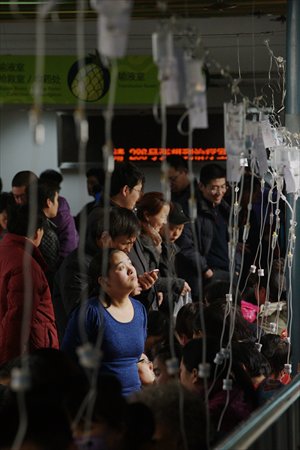Smog could aggravate winter flu, say experts

Medical experts have told the Global Times they worry the recent severe pollution in Beijing may exacerbate the annual winter flu outbreak.
This winter, the main flu strain is still A(H1N1), often referred to as "swine flu" since it first broke out in Mexico in 2009.
According to the latest release from the Beijing Centers for Diseases Control and Prevention (CDC), three people have died of A(H1N1) strain of flu since January 1.
"The three patients had other diseases like cancer and asthma," said Pang Xinghuo, deputy director of the CDC.
While the three patients died before the extreme pollution that has afflicted the capital since Friday, Pang said the smoggy conditions now will exacerbate the spread of A(H1N1), as it will negatively impact people's ability to resist the virus.
"There are pollutants which are harmful to the respiratory tract and the cardiovascular system. And it's easier for the little PM2.5 particles to get deep inside the respiratory tract, which will aggravate the illnesses of patients who have diseases like asthma and pneumonia. So people's ability to resist the flu virus will be degraded," Pang said.
In addition, it is hard for respiratory viruses, including the flu, to disperse when the air is stale and has more pollutants, she said.
"If a flu patient sneezes, the virus in the smoggy air will stay for a longer time than usual. So other people passing by have a higher possibility of breathing the virus in," noted Pang.
A nurse, surnamed Cheng, from Beijing Hospital in Dongcheng district, said that the number of patients seeking flu treatment has risen, and their staff has been affected.
"We are short-staffed more than usual now due to flu," she said.
"People have to wait for about two hours on the waiting list to see emergency doctors here while in ordinary days, the waiting time is just about half an hour," Cheng said.
Doctor Zhong Nanshan, renowned Chinese respiratory disease expert and head of the Guangzhou Institute of Respiratory Diseases in the First Affiliated Hospital of Guangzhou Medical College, told the Global Times that there is no proof that PM2.5 particles can transmit the flu virus.
"However, for patients who catch it, breathing the particles will aggravate the disease, because PM2.5 can penetrate the respiratory tract, and also the [lung] alveoli. For those who have other diseases, their ability to resist the virus will be lowered," said Zhong.
Ma Yanming, media officer of Beijing Municipal Health Bureau, agreed that the conditions could be harmful.
"However, we don't have any figures for the A(H1N1) patients because we can't survey all flu patients," said Ma.
Beijing Municipal Environmental Monitoring Center showed that on Saturday, PM2.5 was over 700 micrograms per cubic meter at some stations, and peaked at over 900 micrograms per cubic meter in some areas.
The World Health Organization indicates that PM2.5 over 25 micrograms per cubic meter is dangerous to the health.
In the latest CDC release, from December 31, 2012 to January 6, 2013, it is estimated that in above second-class medical institutions in Beijing, 30,077 patients came for flu treatment. The number is 3.88 percent higher than the previous week's 28,567 flu patients.
Pang said the flu in Beijing is different from the flu epidemic now spreading in the US.
"H3N2 is the main strain of flu in the US; in Beijing it's H1N1," she said.
According to the Xinhua News Agency Sunday, so far 30 US states have had deaths due to the flu, most of whom were aged over 65 or children.
This US flu season has peaked weeks earlier than usual, and has tipped over into an epidemic, the New York Times reported Friday.
Pang said that so far the flu is controllable in China because the A(H1N1) strain has not mutated.
From July, 2009 to January 17, 2010, 10,966 people caught A(H1N1) in Beijing, and 76 people died, according to the Beijing News on January 6.
"People should pay attention to personal hygiene. Children and the elderly should wear more clothes and schools should conduct regular temperature checks," Pang noted.
A vaccine for this winter's flu is still available in hospitals and clinics in Beijing, and the elderly and children are vaccinated for free. Other people should pay at the clinic.